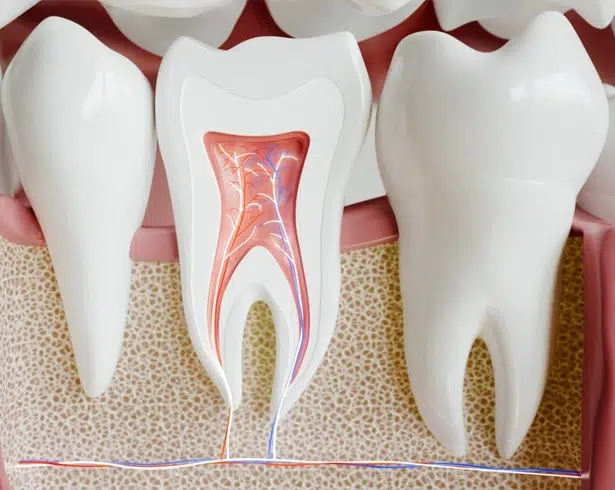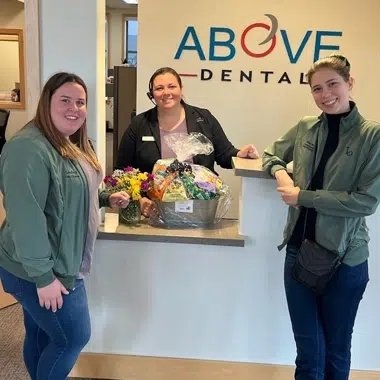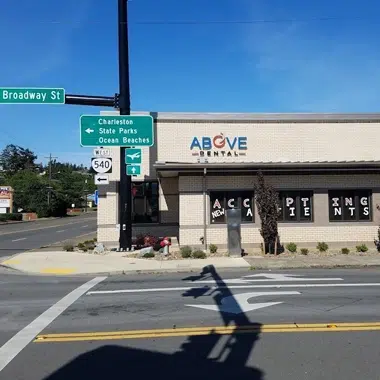
Root Canals
Here is what you need to know.Do you have severe tooth pain caused by a deep infection? Root canal therapy removes infected tooth pulp and cleans the root canals to restore your dental health.
Our North Bend dentists offer gentle root canal procedures using anesthesia to ensure your comfort. While it requires a minor surgical procedure to remove the infection, there’s nothing to worry about because you’re in good hands.
Above Dental customizes your treatment for your needs, and we also offer sedation dentistry to help you relax from start to finish.
Despite popular belief, root canals are painless and actually rid you of pain while saving your natural tooth from extraction.
When Do I Need Root Canal Therapy in North Bend, OR ?
Discover why you might need this tooth-saving procedure.Severe Tooth Damage
Tooth damage can easily be fixed with a dental restoration. However, if the fracture is extreme and exposes the root canal, our dentist may need to remove the pulp before placing a prosthetic. This helps ensure your tooth’s long-term health.Deep Tooth Decay
If decay in a tooth has reached the pulp, the infection may spread into the root canals. This is what causes sensitivity and/or extreme pain inside the tooth. Deep tooth decay is the number one reason why patients need root canal treatment.The Root Canal Process
Our renowned dentists are highly skilled at performing root canal therapy, and they will do everything to save your tooth from extraction.Diagnosis and treatment planning
Before you undergo this treatment, one of our dentists examines your tooth carefully and makes a diagnosis to ensure root canal therapy is the best solution. We do this through x-ray imaging and a clinical assessment. We may be able to do the procedure the same day or will schedule one.Anesthesia
On your scheduled day of surgery, you’ll be given an anesthetic to numb the tooth and the area around it. You can also opt for IV sedation if desired; it’s a safe way to ease any discomfort or fear. Patients who don’t respond to numbing may benefit from sedation.Tooth preparation
Once the anesthetic starts working, our dentist cleans your tooth thoroughly and puts a rubber dam over it. The rubber dam will keep any infectious matter from coming in contact with other teeth, and helps keep the area dry.
We then drill a small hole through the top of the tooth for access to your root canals. The hole must be deep enough to expose the pulp located at the very center of the tooth.
Removal of pulp
Once we expose the infected pulp, we cut it off and remove it from the root canals. Cutting the pulp also cuts the nerves connected to the alveolar bone.
Without nerves, the treated tooth loses all of its sensation, so it’ll no longer experience any sensitivity. The pulp is safe to remove because it doesn’t have any other function apart from connecting the nerves to the tooth.
Cleaning of root canals
Without the pulp, the root canals are now empty and exposed. Using endodontic files, our dentist cleans out the canals and removes all signs of infection.
The files come in various sizes and angles, allowing for efficient cleaning of all the nooks and crannies inside.
Disinfection and sealing
After a thorough cleaning and close examination, we disinfect the root canals using an antiseptic. This helps prevent reinfection and prepares the canals for sealing.
Our dentist then applies a sealant called gutta percha inside the root canals. The inside of the tooth remains hollow due to the removal of the occlusal surface, and we cover the hole by filling the tooth with a composite bonding material. This also protects the tooth from further decay.
Restoration and follow-up
Depending on the size of the hole needed to reach the pulp, you may need a partial or complete crown restoration post-treatment. This restores your tooth and prevents reinfection.
For crowns – we prep your tooth, take impressions, create your crown, and place it after two weeks. You’ll have a temporary crown while we fabricate your permanent one.
At your follow-up visit, our restorative dentist examines how your tooth is responding to your root canal treatment. Next, we place your restoration plus double-check for fit and comfort to ensure a beautiful, healthy smile.




